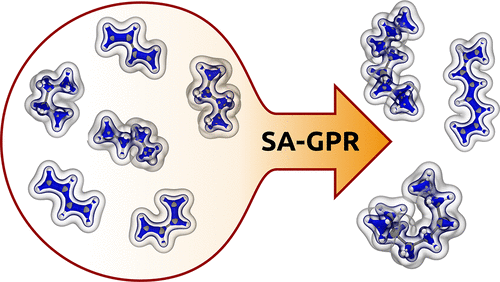当前位置:
X-MOL 学术
›
ACS Cent. Sci.
›
论文详情
Our official English website, www.x-mol.net, welcomes your feedback! (Note: you will need to create a separate account there.)
Transferable Machine-Learning Model of the Electron Density
ACS Central Science ( IF 18.2 ) Pub Date : 2018-12-26 00:00:00 , DOI: 10.1021/acscentsci.8b00551 Andrea Grisafi 1, 2 , Alberto Fabrizio 2, 3 , Benjamin Meyer 2, 3 , David M Wilkins 1 , Clemence Corminboeuf 2, 3 , Michele Ceriotti 1
ACS Central Science ( IF 18.2 ) Pub Date : 2018-12-26 00:00:00 , DOI: 10.1021/acscentsci.8b00551 Andrea Grisafi 1, 2 , Alberto Fabrizio 2, 3 , Benjamin Meyer 2, 3 , David M Wilkins 1 , Clemence Corminboeuf 2, 3 , Michele Ceriotti 1
Affiliation

|
The electronic charge density plays a central role in determining the behavior of matter at the atomic scale, but its computational evaluation requires demanding electronic-structure calculations. We introduce an atom-centered, symmetry-adapted framework to machine-learn the valence charge density based on a small number of reference calculations. The model is highly transferable, meaning it can be trained on electronic-structure data of small molecules and used to predict the charge density of larger compounds with low, linear-scaling cost. Applications are shown for various hydrocarbon molecules of increasing complexity and flexibility, and demonstrate the accuracy of the model when predicting the density on octane and octatetraene after training exclusively on butane and butadiene. This transferable, data-driven model can be used to interpret experiments, accelerate electronic structure calculations, and compute electrostatic interactions in molecules and condensed-phase systems.
中文翻译:

电子密度的可迁移机器学习模型
电子电荷密度在确定原子尺度物质的行为方面发挥着核心作用,但其计算评估需要严格的电子结构计算。我们引入了一种以原子为中心、对称性适应的框架,可以根据少量参考计算来机器学习价电荷密度。该模型具有高度可移植性,这意味着它可以根据小分子的电子结构数据进行训练,并用于以较低的线性缩放成本预测较大化合物的电荷密度。展示了复杂性和灵活性不断增加的各种碳氢化合物的应用,并证明了在仅对丁烷和丁二烯进行训练后预测辛烷和辛四烯密度时模型的准确性。这种可转移的数据驱动模型可用于解释实验、加速电子结构计算以及计算分子和凝聚相系统中的静电相互作用。
更新日期:2018-12-26
中文翻译:

电子密度的可迁移机器学习模型
电子电荷密度在确定原子尺度物质的行为方面发挥着核心作用,但其计算评估需要严格的电子结构计算。我们引入了一种以原子为中心、对称性适应的框架,可以根据少量参考计算来机器学习价电荷密度。该模型具有高度可移植性,这意味着它可以根据小分子的电子结构数据进行训练,并用于以较低的线性缩放成本预测较大化合物的电荷密度。展示了复杂性和灵活性不断增加的各种碳氢化合物的应用,并证明了在仅对丁烷和丁二烯进行训练后预测辛烷和辛四烯密度时模型的准确性。这种可转移的数据驱动模型可用于解释实验、加速电子结构计算以及计算分子和凝聚相系统中的静电相互作用。



























 京公网安备 11010802027423号
京公网安备 11010802027423号